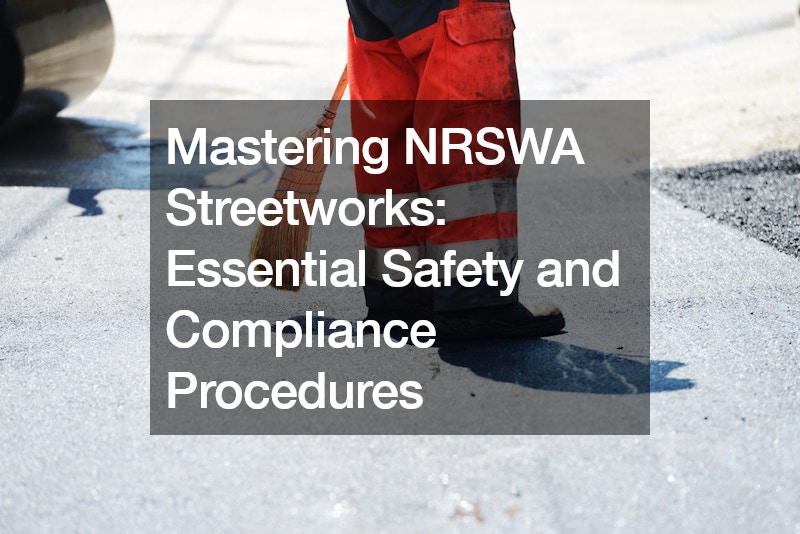The New Roads and Street Works Act (NRSWA) sets out the legal framework for street works carried out by utility companies and contractors in the UK. Mastering the procedures and compliance requirements of NRSWA streetworks is essential for ensuring safety, efficiency, and the protection of public infrastructure. This article explores key safety and compliance procedures that must be adhered to during NRSWA streetworks to minimize risks and ensure successful project execution. For those looking to deepen their understanding, NRSWA streetworks training courses are invaluable in providing comprehensive knowledge and practical skills.
Understanding NRSWA Streetworks NRSWA streetworks involve excavating, repairing, and maintaining utility services beneath roads and pavements. These operations require meticulous planning and adherence to safety standards to prevent accidents, damage to existing infrastructure, and disruption to public services.
The importance of following NRSWA regulations cannot be overstated, as non-compliance can result in severe penalties and jeopardize public safety.
Site Preparation and Documentation Before any NRSWA streetworks begin, comprehensive site preparation and documentation are critical. The following steps should be taken:
Site Setup: Establish the worksite in accordance with safety regulations, ensuring it is clearly marked and secure. This involves setting up barriers, signs, and warning signals to alert pedestrians and drivers.
Documentation: Obtain all necessary permits and ensure the site complies with the Red Book guidelines. Conduct a thorough site survey to identify any potential hazards, such as overhead cables, underground services, and nearby trees.
Inspection and Verification: Check and recheck site documentation, including the SSRA (Site Safety Risk Assessment) and other permits. Conduct a walk-through of the area to look for any signs of ground scarring or marking, which could indicate underlying services.
Using Appropriate Equipment and Protective Gear Safety during NRSWA streetworks heavily depends on using the right equipment and protective gear. Workers must be equipped with:
Personal Protective Equipment (PPE): Standard PPE includes masks, eye protection, ear defenders, gloves, and flame-retardant overalls. Ensure that all workers undergo face-fit tests for dust masks to guarantee an adequate fit.
Tools and Machinery: When working with tarmac or concrete, use appropriate tools such as petrol or floor saws with water suppression systems to control dust and cool the blades. Only trained personnel with the necessary qualifications should operate these tools to prevent accidents.
Utility Detection Equipment: Use CAT (Cable Avoidance Tool) and Genny (Signal Generator) together as a combined unit to locate underground cables and pipes before excavation begins. Perform daily functional checks on these tools to ensure they are working correctly.
Safe Excavation Practices Excavation is one of the most hazardous aspects of NRSWA streetworks. To ensure safety:
Marking and Mapping: Accurately mark the location of all utilities at least 500 millimeters outside the excavation area to maintain visibility during the digging process.
Hand Digging: Use hand tools for excavation to avoid damaging underground services. Carefully remove the top layer of soil and use safety shovels to reduce the risk of personal injury and utility damage.
Mechanical Assistance: If mechanical excavation is necessary, ensure it is done cautiously. Keep all personnel clear of the excavation area and use mechanical lifting aids for heavy objects like slabs, pavers, or curbs. Properly store removed materials to prevent obstructions or hazards.
Risk Management and Hazard Mitigation Managing risks and mitigating hazards is crucial for the safety of both workers and the public. Key practices include:
Ongoing Assessment: Continuously monitor ground conditions and adjust plans as necessary. Be vigilant for changes in ground makeup or loose-fill around utilities, which could indicate potential hazards.
Service Identification: When utilities are identified, uncover them along their entire length to understand their exact placement. Segregate excavated materials to prevent cross-contamination and damage to the existing surface.
Damage Prevention: Avoid mechanical excavation within 500 millimeters of any identified utilities. If utilities are found to be closer to the surface than expected, take extra care during digging. Contact the utility owner for guidance if breaking out concrete around power cables is required.
Emergency Procedures and Reporting Despite all precautions, accidents can happen. Being prepared for emergencies and knowing how to report incidents is essential:
Emergency Protocols: Have clear emergency procedures, such as isolating the area, preventing access, and contacting emergency services if necessary. Ensure all workers are trained to handle emergencies.
Damage Reporting: Immediately report any damage to utilities to the supervisor and document the damage with photographs. Make the area safe and prevent further access until repairs are made.
Gas Leaks and Electrical Hazards: In the event of a gas leak, evacuate the area and follow company emergency procedures. For electrical hazards, do not approach the site and ensure that only trained personnel handle the situation.
Conclusion Mastering NRSWA streetworks requires a thorough understanding of safety protocols, adherence to regulations, and meticulous planning. By following these essential safety and compliance procedures, contractors and utility companies can ensure the successful completion of street works while safeguarding public infrastructure and minimizing risks. Compliance with NRSWA regulations protects workers and the public and contributes to the efficient and safe operation of vital utility services. Enrolling in NRSWA streetworks training courses can provide the necessary knowledge and skills to manage and execute these complex tasks effectively.
.

